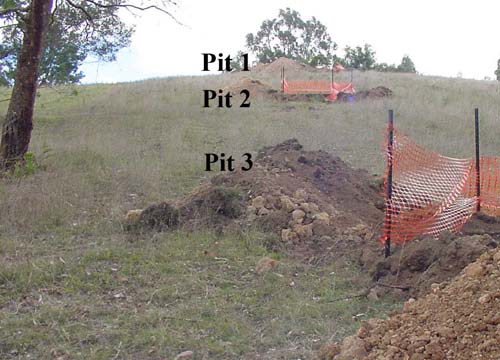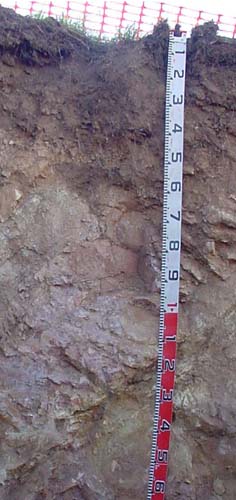EGS263
Location: Wiseleigh
Australian Soil Classification: Melacic, Dystrophic, Brown KUROSOL
Map Unit: Tambo (Component 1)
Previous Site Name: EG263
General Landscape Description: Rolling low hills.
Site Description: Upper south slope, 15% slope.
Land Use: Grazing.
Native Vegetation: Grassy woodland.
Geology: Ordovician sediments.

Sequence of soil pits examined at Wiseleigh
Soil Profile Morphology:
Surface Soil
| A11 | 0 – 5 cm | Black (10YR2/1); loam; strong fine granular structure; weak consistence moderately moist; wavy change to: |  EG263 Profile |
| A12 | 5 – 30 cm | Dark brown (7.5YR3/2); loam; moderate fine subangular blocky structure; firm consistence moderately moist; few (2-10 %) angular pebbles (20-60 mm) of parent rock; wavy change to: | |
| Subsoil | |||
| B2 | 30 – 50 cm | Dark reddish brown (5YR3/2); medium clay; weak fine polyhedral structure; firm consistence moderately moist; common (10-20%) angular pebbles (20-60 mm) of parent rock; wavy change to: | |
| C | 50 – 70 cm | Brown (7.5YR4/3); sandy loam; massive; firm consistence moderately moist; abundant (50-90%) angular pebbles and cobbles (<200 mm) mm) of parent rock; wavy change to: | |
| R | 100 cm+ | Weak rock becoming stronger with depth |
Key Profile Features:
- Texture contrast between the surface (A) horizons and the subsoil (B horizons).
- Very high organic matter in the surface soil, which enhances nutrient and water-holding capacity.
Soil Profile Characteristics:
Surface soil (A11) | Very Strongly Acid | Non-Sodic | - |
Subsoil (B2 horizon) | Very Strongly Acid | Non-Sodic | None |
Deep subsoil (C horizon) | Strongly Acid | Non-Sodic | None |
Chemical and Physical Analysis:
Horizon | Horizon Depth (cm) | pH (water) | pH CaCl2 | CE dS/m | Organic Carbon % | Total Nitrogen % | Exch. Al | Exch. Acididty meq/100g | Exchangeable Cations | Coarse Sand (0.2-2.0 mm) % | Fine Sand (0.02-0.2 mm) % | Silt (0.002-0.02 mm) % | Clay (<0.002 mm) % | Field cap. % w/w | Wilt. point % w/w | |||
Ca | Mg | K | Na | |||||||||||||||
meq/100g | ||||||||||||||||||
A11 | 0-5 | 4.8 | 4.2 | 0.13 | 14 | 0.77 | 220 | 21 | 5.5 | 2.6 | 0.7 | <0.1 | 27 | 27 | 7 | 23 | 51.7 | 27.4 |
A12 | 5-30 | 4.8 | 4.2 | 0.05 | 4.6 | 0.18 | 500 | 22 | 0.5 | 0.4 | 0.2 | <0.1 | 23 | 24 | 23 | 21 | 41.6 | 13.2 |
B2 | 30-50 | 5 | 4.4 | <0.05 | 2.2 | 0.1 | 240 | 15 | <0.1 | 0.1 | 0.1 | <0.1 | 29 | 23 | 2 | 44 | 34.1 | 10.4 |
C | 50-70 | 5.1 | 4.7 | <0.05 | 92 | 5.3 | <0.1 | <0.1 | <0.1 | <0.1 | 40 | 18 | 26 | 16 | 21.7 | 7.1 | ||
Management Considerations
Whole profile
- On the assumption the roots can extract the water in the top 50 cm of the soil, the plant available water capacity is estimated at 56 mm. The high amounts of organic matter in this surface soil have added to the soil’s ability to retain water.
Surface (A) horizons
- The surface soil is very strongly acidic and the high levels of exchangeable aluminium are likely to restrict the growth of aluminium sensitive species. A response to lime would be expected, but before it is applied, test strips should be used to evaluate the cost/benefit.
- The nutrient holding capacity of the immediate surface soil is moderate (based on the sum of the basic cations) largely due to its high organic matter content. The immediate subsurface soil has an extremely low nutrient holding capacity.
Subsoil (B) horizons
- Based on the sum of the basic cations, the subsoil has an extremely low nutrient holding capacity.
- The subsoil is non-sodic and not dispersive. Given the presence of increasing amounts of rock down the profile, gully and tunnel erosion in this particular soil is unlikely
Profile Described By: Ian Sargeant (2011).


